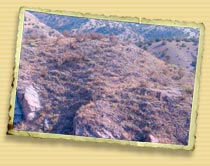


Since 1999, the Caņada Alamosa Project has been systematically testing four sites, each located less
than one mile from the others. Collectively their temporal components span the time period from circa A.D. 600 to A.D.
1400. These sites are
the Montoya Site (LA 88891),
the Kelly Canyon Site (LA 1125),
the Victorio Site (LA 88889) and the
Pinnacle Site (LA 2292). All are located on private land owned by Dr. Dennis and Trudy O'Toole, founders of the Cañada Alamosa
Institute.



The Montoya Site is a 30-room pueblo of primarily jacal (wattle and daub) construction. Ceramics and radiocarbon dates suggest that the jacales are associated with the southern pueblo Mimbres Tradition in the late 1000s and early 1100s. The Montoya Site is one of many sites containing Mimbres white ware in the study area. Most are constructed of jacal and contain artifact assemblages that suggest multiple short-term occupations. Socorro Black-on-White, affiliated with the northern pueblo tradition appears as a trade ware, an interpretation supported by frequent association of the two types on sites located on survey in the canyon.
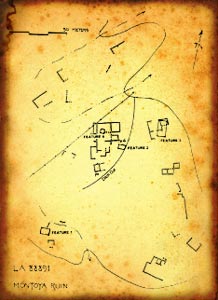



The Kelly Canyon Site is a mixed masonry/jacal pueblo. Socorro Black-on-White is the dominant painted ware to the virtual exclusion of Mimbres Black-on-White The utility ceramics are also linked to the northern pueblo world. The pueblo's linear configuration and associated kiva are identical to sites found 60 to 100 miles north in the northern pueblo heartland at the time of the Chaco fluorescence. The data suggests a strong Socorro Tradition occupation spanning that elusive period from A.D. 1130 to A.D. 1200, thereby possibly overlapping and clearly postdating the Mimbres component at the Montoya site. Kelly Canyon Site and nearby communities are the southernmost Socorro Tradition sites.
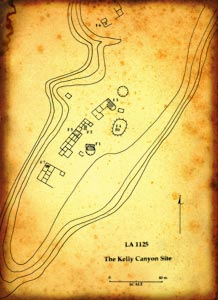


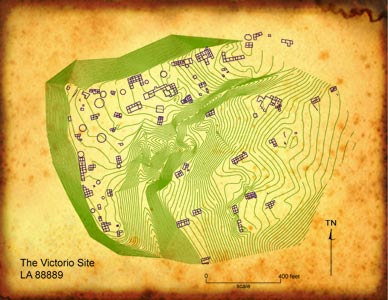

The 447-room Victorio Site contains at least three components. The earliest is a 7th to 8th century pithouse village with a ceramic assemblage affiliated with the early southern pueblo (Mogollon) tradition (e.g., Mogollon Red-on-brown, San Francisco Red, Alma Neck Banded, and Mimbres Boldface Black-on-White) but that also contains sherds from the early northern traditions (San Marcial/White Mound Black-on-White and Kiatuthlana Black-on-White). Curiously, ceramics representing the 9th and 10th centuries are rare. Current data suggests that the Victorio Site was certainly occupied at the end of the Mimbres phase (11th century) and then grew exponentially during the 12th century in tandem with the arrival of the Socorro Tradition population at the Kelly Canyon site. Finally, the last component on the site consists of a number of masonry room blocks containing Tularosa Black-on-White, a ceramic type associated with the emergence of the Zuni area as a replacement for the, by then, collapsed center at Chaco. St. Johns Polychrome and Chupadero Black-on-White are added to the ceramic inventory during this phase. It was a time of intense aggregation in the canyon as survey data indicated that almost everyone was living at or near the Victorio Site. Radiocarbon dates suggest that occupation ended circa. A.D. 1300.


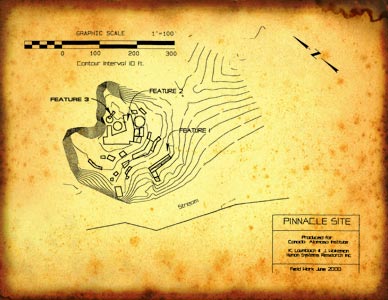

The most recent of the four sites, the Pinnacle Ruin, has seen six seasons of excavation by Steve Lekson and the University of Colorado. Built on a steep uplift, retaining walls and rooms were terraced into the slope. Remote sensing indicates that anywhere from 150 to 300 rooms are probably present. The earliest ceramic assemblage is distinguished by carbon paint McElmo/Mesa Verde look-alike Magdalena Black-on-White followed by a sequence of late White Mountain red wares including early Zuni glaze wares (Heshotauthla Glaze Polychrome, Pinedale Polychrome and Kwakina Glaze Polychrome). The compound masonry, formal midden and carbon paint ceramics have led Lekson to postulate the arrival of an immigrant community from the Mesa Verde culture area during the 1200s. Dating further suggests that the immigrants arrived while the Victorio Site was still occupied. Excavations have revealed that the Pinnacle Ruin experienced either a remodeling or a reoccupation during the 1300s when glaze paint wares affiliated with the Zuni tradition replaced the carbon paint wares. Only two other contemporary sites are present in the canyon. Final abandonment occurred circa A.D. 1400.
• The Cañada Alamosa Project: Before A.D. 1400: The Pueblo History of the Canyon
• The Cañada Alamosa Project: The Post Pueblo Period: After A.D. 1400
• The Archaeological Sites at Cañada Alamosa
• The Cañada Alamosa Project: Current Interpretations







